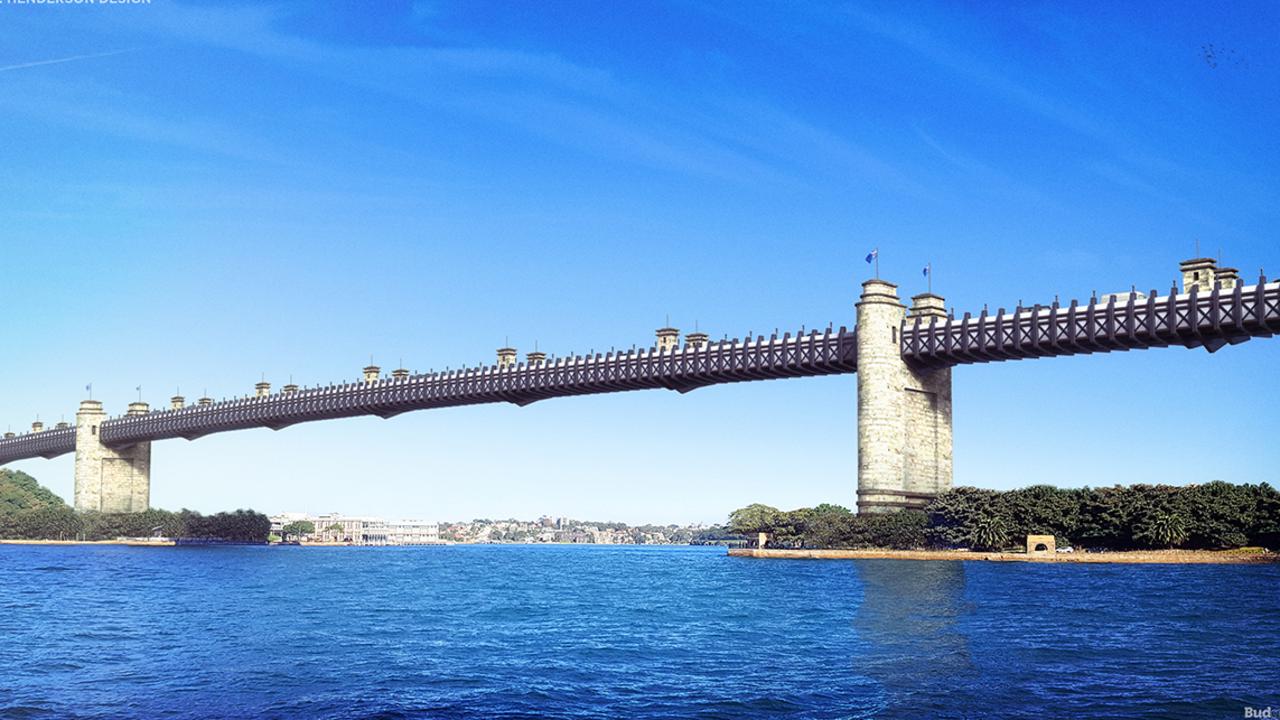New digital images show what Sydney Harbour Bridge outtakes would have looked like
Incredible new images have revealed what Sydney would look like today had some of the alternative Harbour Bridge designs been given the green light.

Innovation
Don't miss out on the headlines from Innovation. Followed categories will be added to My News.
It’s almost 96 years to the day since one of Australia’s greatest landmarks — the Sydney Harbour Bridge — began the early stages of its life.
But before construction officially started on July 28, 1923, there was the small issue of deciding what the skyline-defining structure would look like.
That process began in 1900, when the Australian government decided to hold a worldwide competition for its design and construction.
Dorman Long eventually won the contract several competitions later for a design that would make the bridge one of the world’s most iconic landmarks.

However, there were more than 70 other idea from around the world that didn’t make the cut.
One of them — F. Ernest Stowe’s radical three-way structure connecting Balls Head, Millers Point and Balmain with a memorial tower and hub on Goat Island — was only narrowly rejected by the government.
In a bid to see whether the government made the right call, Budget Direct commissioned digital artists to recreate what the Sydney Harbour Bridge would look like if six of the rejected entries had won.
Here’s what our world famous harbour could have looked like had they been given the nod …
1. Norman Selfe’s design
Shortly after the competition kicked off, bearded Australian engineer and inventor Norman Selfe came up with a design, that featured three arches, in 1902.
His design was actually accepted by the New South Wales authorities.
The selection board said at the time: “The structural lines are correct and in true proportion, and … the outline is graceful”.
However, an economic slowdown resulted in a new government that rejected the whole project, so the bridge remained unbuilt.
To add insult to injury, he couldn’t claim his prize money or £20,000 for further work he did on the designs.
However, his legacy in Sydney lives, particularly on the upper north shore where the suburb Normanhurst is named after him.


2. Dorman Long & Co. Ltd’s designs
Dorman Long, a steel company from northeast England, won the final competition in 1924 with the design that we all know and love. But, it also submitted a total of seven alternative designs.
One of these was a cantilever bridge with the centre span of 0.49km.
However, the design failed to meet the required specifications because they used precast concrete blocks rather than granite.

Another design by the company was considered by judges to be “simple and elegant, but aesthetically too severe for its setting”.

3. F. Ernest Stowe’s design
Francis Ernest Stowe was an architect and engineer who practised at Parramatta and submitted this radical design in the 1922 competition.
The design links Balls Head, Miller’s Point and Balmain, meeting in the middle with a central tower on Goat Island.

The central tower was to be 152m high and was designed to double as a war memorial, with Goat Island renamed Anzac Isle.
He said at the time: “The whole of the material required for its construction can be manufactured in Australia, as the heavy weight-carrying cables are spun and formed from fine wire. The structural members need only be very light sections”.

However, his ambitious plans were narrowly rejected by the government.
4. P.E. Henderson’s design
A bridge across the harbour was first proposed back in 1815 when architect and convict Francis Greenway suggested it to the Governor Lachlan Macquarie.
A floating bridge was planned in 1840 by naval architect Robert Brindley, but one of the
earliest known plans drawn up was this proposal by engineer Peter Henderson.


5. David B. Steinman & Holton D. Robinson’s design
Two American architects, Robinson & Steinman created this design in 1924.
It combined the principles of both cantilever and suspension bridges and was said to be a suspension bridge of novel design more rigid than any other at the time.


However, it wasn‘t popular and the official report criticised the overall appearance of the design, saying that “the bridge would not have a pleasing outline”.
Despite this, the pair would successfully design bridges all over the world.
6. McClintic Marshall Products Company’s design
This American steel company was involved in the construction of the George Washington Bridge and the Golden Gate Bridge.
It submitted this design, along with a number of others for the 1924 competition.

Their designs incorporated cantilever bridges, suspension bridges and an arch bridge.
However, it was not favoured and judges, who felt it wouldn‘t “harmonise with its surroundings”.

Judges made the right call
Budget Direct surveyed 1000 people using these images to see whether judges made the right decision.
And, it looks like they did as 61.8 per cent said the winning design was their favourite.
The next most popular was Norman Selfe’s design, with 10.4 per cent of the votes
Originally published as New digital images show what Sydney Harbour Bridge outtakes would have looked like







